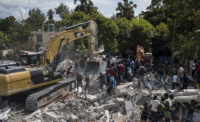...it has very limited tension strength and behaves in a brittle manner."
Concrete is a more expensive but better option although it may not be sufficient in the face of a major quake if adequate stirrup ties – horizontal loops around the vertical rebar – are not included. Their omission can also result in brittle behavior, he said.
In Lima, more than 120 miles northeast of the earthquake's center, buildings shook but few fell. The civil defense agency, Indeci, reported serious damage to structures in nine of the city's 30 municipal departments. Most of the hundreds of homes affected did not collapse during the earthquake but have been at high risk due to the damage.
Several of the most affected municipalities are former pueblos jovenes–or shantytowns–which have been improved but still house some of the city's poorest residents. Construction in many of these districts, such as Villa El Salvador and San Juan de Lurigancho, is often done without any sort of permit or safety regulation.
The quake failed to knock out Lima's water supply and the agency in charge, the Superintendencia Nacional de Servicios de Saneamiento, says the quake had damaged some of the water infrastructure but not critically.
A priority was sending dozens of cistern trucks with drinking water into areas where water supply had been completely stopped.
The quake delivered a severe blow to the transportation network, ripping apart stretches of the PanAmerica Highway between the hardest hit areas and Lima. The damage has hindered aid efforts significantly.
Within hours of the quake, Vial del Perú – the concessionaire working on upgrading the roadway between Pucusana and Ica – was able to get some of its equipment into place to prepare makeshift repairs so limited traffic could resume.
The 120–mile trip from Lima to Pisco now takes as much as eight hours due to backups at points where the road is severely damaged. At night, these traffic stoppages aid thieves who ransack aid vehicles stuck in the traffic.
The day after the quake, the ministry mobilized 9,000 workers to clean rocks and debris from the roadway that had been caused by rockslides. Crews with Luz del Sur, Peru's main electrical service provider, mobilized to start repairing fallen power lines along the roadway to get service back to the region.
The San Clemente Huamaní bridge leading into Pisco suffered heavy damage and traffic across it was limited to one direction as a precaution. Bulldozers cleared a makeshift roadway across the shallow riverbed for northbound traffic – a measure that increased the traffic woes even further.
The road damage not only is hindering aid efforts but, officials fear it will heavily dent the economic capability of the region unless it is fixed soon. The sale of exports from the region reached more than $1.285 billion last year–making it part of the region's economic foundation.
Already, bus services that have routes through the region have reported the loss of more than $1 million in business, reported the Asociación de Omnibus Interprovinciales del Perú.
The department of Ica is sustained by agriculture and textile exports and organizations representing those groups urged the government to move quickly in repairing the roadway.


Post a comment to this article
Report Abusive Comment